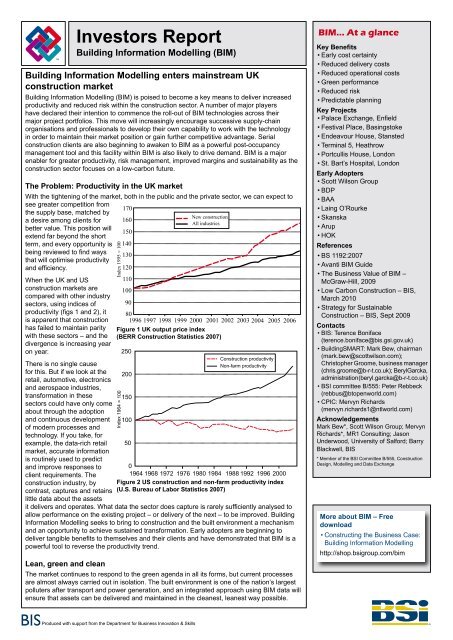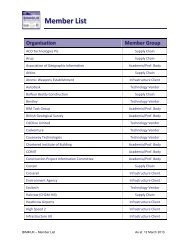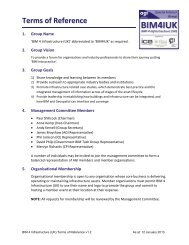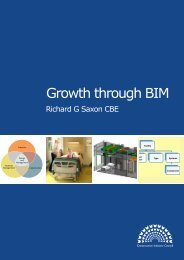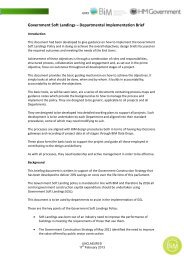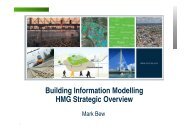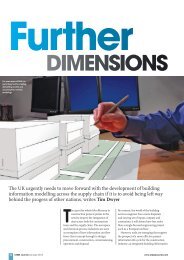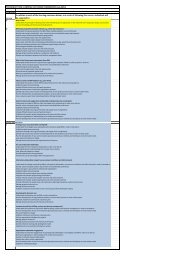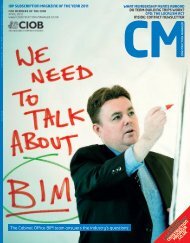Investors Report - BIM Task Group
Investors Report - BIM Task Group
Investors Report - BIM Task Group
Create successful ePaper yourself
Turn your PDF publications into a flip-book with our unique Google optimized e-Paper software.
Building Information Modelling enters mainstream UK<br />
construction market<br />
Building Information Modelling (<strong>BIM</strong>) is poised to become a key means to deliver increased<br />
productivity and reduced risk within the construction sector. A number of major players<br />
have declared their intention to commence the roll-out of <strong>BIM</strong> technologies across their<br />
major project portfolios. This move will increasingly encourage successive supply-chain<br />
organisations and professionals to develop their own capability to work with the technology<br />
in order to maintain their market position or gain further competitive advantage. Serial<br />
construction clients are also beginning to awaken to <strong>BIM</strong> as a powerful post-occupancy<br />
management tool and this facility within <strong>BIM</strong> is also likely to drive demand. <strong>BIM</strong> is a major<br />
enabler for greater productivity, risk management, improved margins and sustainability as the<br />
construction sector focuses on a low-carbon future.<br />
The Problem: Productivity in the UK market<br />
With the tightening of the market, both in the public and the private sector, we can expect to<br />
see greater competition from<br />
170<br />
the supply base, matched by<br />
New construction<br />
a desire among clients for 160<br />
All industries<br />
better value. This position will<br />
150<br />
extend far beyond the short<br />
term, and every opportunity is 140<br />
being reviewed to find ways 130<br />
that will optimise productivity<br />
and efficiency.<br />
120<br />
When the UK and US<br />
construction markets are<br />
compared with other industry<br />
sectors, using indices of<br />
productivity (figs 1 and 2), it<br />
is apparent that construction<br />
has failed to maintain parity<br />
with these sectors – and the<br />
divergence is increasing year<br />
on year.<br />
There is no single cause<br />
for this. But if we look at the<br />
retail, automotive, electronics<br />
and aerospace industries,<br />
transformation in these<br />
sectors could have only come<br />
about through the adoption<br />
and continuous development<br />
of modern processes and<br />
technology. If you take, for<br />
example, the data-rich retail<br />
market, accurate information<br />
is routinely used to predict<br />
and improve responses to<br />
client requirements. The<br />
construction industry, by<br />
contrast, captures and retains<br />
little data about the assets<br />
<strong>Investors</strong> <strong>Report</strong><br />
Building Information Modelling (<strong>BIM</strong>)<br />
Index 1995 = 100<br />
Index 1964 = 100<br />
110<br />
100<br />
90<br />
80<br />
1996 1997 1998 1999 2000 2001 2002 2003 2004 2005 2006<br />
Figure 1 UK output price index<br />
(BERR Construction Statistics 2007)<br />
250<br />
200<br />
150<br />
100<br />
50<br />
Construction productivity<br />
Non-farm productivity<br />
0<br />
1964 1968 1972 1976 1980 1984 1988 1992 1996 2000<br />
Figure 2 US construction and non-farm productivity index<br />
(U.S. Bureau of Labor Statistics 2007)<br />
it delivers and operates. What data the sector does capture is rarely sufficiently analysed to<br />
allow performance on the existing project – or delivery of the next – to be improved. Building<br />
Information Modelling seeks to bring to construction and the built environment a mechanism<br />
and an opportunity to achieve sustained transformation. Early adopters are beginning to<br />
deliver tangible benefits to themselves and their clients and have demonstrated that <strong>BIM</strong> is a<br />
powerful tool to reverse the productivity trend.<br />
Lean, green and clean<br />
The market continues to respond to the green agenda in all its forms, but current processes<br />
are almost always carried out in isolation. The built environment is one of the nation’s largest<br />
polluters after transport and power generation, and an integrated approach using <strong>BIM</strong> data will<br />
ensure that assets can be delivered and maintained in the cleanest, leanest way possible.<br />
<strong>BIM</strong>… At a glance<br />
Key Benefits<br />
• Early cost certainty<br />
• Reduced delivery costs<br />
• Reduced operational costs<br />
• Green performance<br />
• Reduced risk<br />
• Predictable planning<br />
Key Projects<br />
• Palace Exchange, Enfield<br />
• Festival Place, Basingstoke<br />
• Endeavour House, Stansted<br />
• Terminal 5, Heathrow<br />
• Portcullis House, London<br />
• St. Bart’s Hospital, London<br />
Early Adopters<br />
• Scott Wilson <strong>Group</strong><br />
• BDP<br />
• BAA<br />
• Laing O’Rourke<br />
• Skanska<br />
• Arup<br />
• HOK<br />
References<br />
• BS 1192:2007<br />
• Avanti <strong>BIM</strong> Guide<br />
• The Business Value of <strong>BIM</strong> –<br />
McGraw-Hill, 2009<br />
• Low Carbon Construction – BIS,<br />
March 2010<br />
• Strategy for Sustainable<br />
Construction – BIS, Sept 2009<br />
Contacts<br />
• BIS: Terence Boniface<br />
(terence.boniface@bis.gsi.gov.uk)<br />
• BuildingSMART: Mark Bew, chairman<br />
(mark.bew@scottwilson.com);<br />
Christopher Groome, business manager<br />
(chris.groome@b-r-t.co.uk); Beryl Garcka,<br />
administration (beryl.garcka@b-r-t.co.uk)<br />
• BSI committee B/555: Peter Rebbeck<br />
(rebbus@btopenworld.com)<br />
• CPIC: Mervyn Richards<br />
(mervyn.richards1@ntlworld.com)<br />
Acknowledgements<br />
Mark Bew*, Scott Wilson <strong>Group</strong>; Mervyn<br />
Richards*, MR1 Consulting; Jason<br />
Underwood, University of Salford; Barry<br />
Blackwell, BIS<br />
* Member of the BSI Committee B/555, Construction<br />
Design, Modelling and Data Exchange<br />
More about <strong>BIM</strong> – Free<br />
download<br />
• Constructing the Business Case:<br />
Building Information Modelling<br />
http://shop.bsigroup.com/bim<br />
Produced with support from the Department for Business Innovation & Skills
What is Building Information Modelling?<br />
Building Information Modelling (<strong>BIM</strong>) is the process of generating and<br />
managing information about a building during its entire life cycle.<br />
<strong>BIM</strong> is a suite of technologies and processes that integrate to form the<br />
‘system’ at the heart of which is a component-based 3D representation of each<br />
building element; this supersedes traditional design tools currently in use. Each<br />
component is generated from a product library and has embedded information<br />
about the product and its placement, material, specification, fire rating, U-value,<br />
fittings, finishes, costs, ‘carbon content’ and any special requirements, which is<br />
stored in the system. As the design progresses, so the integrated information<br />
becomes more valuable. Sophisticated applications and clash detection can<br />
rapidly identify issues which can be designed out at an early stage. <strong>BIM</strong> could be<br />
mistaken for a simple design tool but this overlooks the fact that it is the way the<br />
system generates interfaces to and uses information from other systems which<br />
is fundamental to the delivery of greater benefits. These benefits accrue to the<br />
whole supply chain through the collaborative, integrated use of <strong>BIM</strong>.<br />
There are parallels between <strong>BIM</strong> and the EPOS (electronic point of sale) and<br />
ERP (enterprise resource planning) systems ubiquitously found in the retail<br />
sector. There is a clear interface between <strong>BIM</strong> and organisational corporate<br />
© Scott Wilson <strong>Group</strong> 2010<br />
systems – including those dealing with procurement, finance and supply chain performance. As the graphic (above right) shows, <strong>BIM</strong> sits<br />
at the heart of an information web which includes systems directly attributed to design, construction and those business support systems<br />
which are used to ensure overall efficient asset and corporate performance.<br />
Why Should I Consider <strong>BIM</strong>?<br />
There is some published commercial research<br />
and data gathered from case studies. The<br />
case studies mentioned as ‘key projects’ in<br />
the right-hand panel on the previous page<br />
have been summarised in the graph (right).<br />
The red plot indicates the average saving of<br />
projects available for measurement to date,<br />
with the green plot indicating potential benefits<br />
expected by the early adopter community.<br />
Most of the data covered the design, preconstruction<br />
and construction stages. There<br />
were clear wins in design understanding,<br />
spatial and design co-ordination and 4D<br />
programme integration. Benefits post<br />
construction have still to be measured.<br />
Clearly, this demonstrates considerable<br />
upside potential, especially when the<br />
processes are applied to the entire project<br />
life cycle through to facilities management.<br />
These benefits increase further year on year,<br />
as around 80% of an asset’s cost is incurred<br />
during its operational phase. Whilst our case<br />
studies have focused on monetary benefits,<br />
studies are ongoing to establish similar<br />
relationships for carbon.<br />
Preparation<br />
Design<br />
Pre-construction<br />
Construction<br />
Use<br />
A<br />
B<br />
C<br />
D<br />
E<br />
F<br />
G<br />
H<br />
J<br />
K<br />
L<br />
Appraisal<br />
Design brief<br />
Concept<br />
Design<br />
development<br />
Technical<br />
design<br />
Product<br />
information<br />
Tender<br />
documentation<br />
Tender<br />
action<br />
Mobilisation<br />
Construction<br />
to practical<br />
completion<br />
Post practical<br />
completion<br />
% Benefit 20 40 60 80<br />
There is limited data other than empirical to indicate tangible savings at the early<br />
stages of projects in the UK to date. It is expected that the majority of future savings<br />
will be made through the use of data available from the result of feeding performance<br />
information into the project libraries and enabling better informed early design<br />
All case study projects identified improvements at the actual delivery of design<br />
stages, with understanding and spatial co-ordination the two clear big wins<br />
The data sample available for us to draw conclusions shows reductions of 8–18% on<br />
design fees in the main three design disciplines<br />
Measured benefit<br />
Upside potential<br />
There are identifiable savings made on the co-ordination of trade contractor design<br />
information (especially co-ordination and workshop design)<br />
The sample is consistent and shows figures of 8–<br />
10% of construction cost<br />
Key savings here are around the delivery of co-ordinated clear information to the<br />
construction team. The use of 4D programme integration offers clear understanding<br />
to package teams both in terms of the build, but also work-face co-ordination,<br />
productivity and health and safety<br />
The case study sample consistently shows figures of 8–<br />
10% of construction cost<br />
There is limited data other than empirical to indicate tangible savings at the late<br />
stages of projects in the UK to date. It is expected that the majority of future savings<br />
will be made through the use of data available to better manage assets and plant to<br />
reduce costs through applying proactive techniques<br />
Note: Letters in second column refer to RIBA plan of work.<br />
© Adapted Mark Bew – IGI Global 2010<br />
Key<br />
IFC Industry Foundation Classes<br />
IFD International Framework Dictionary<br />
IDM Information Delivery Manual<br />
i<strong>BIM</strong> Integrated <strong>BIM</strong><br />
CPIC Construction Project Information<br />
Committee<br />
AIMArchitectural information model<br />
SIM Structural information model<br />
FIM Facilities information model<br />
BSIM Building services information model<br />
BrIM Bridge information model<br />
Level 0<br />
CAD<br />
Level 1<br />
2D<br />
3D<br />
Moving up through the levels<br />
of technology use leads to<br />
seamless working and effective<br />
data and process management<br />
Level 3<br />
Level 2<br />
<strong>BIM</strong>s<br />
AIM<br />
SIM<br />
FIM<br />
BSIM<br />
BrIM<br />
CPIC<br />
ISO <strong>BIM</strong><br />
Avanti<br />
BS 1192:2007<br />
User guides CPIC, Avanti, BSI<br />
i<strong>BIM</strong><br />
Standards for<br />
interoperability:<br />
IFC, IFD, IDM<br />
Asset life cycle management<br />
Data management<br />
Process management<br />
Evolution Not Revolution<br />
As this illustration shows, <strong>BIM</strong> continues<br />
to develop. Clearly, not all businesses will<br />
adopt systems and technologies at the same<br />
rate. However, just like organisations in the retail<br />
sector before them, <strong>BIM</strong> adopters will need to<br />
go though a managed process of change which<br />
encompasses not only their internal organisation<br />
but also the way they interface with their external<br />
supply-base and clients. The majority of the UK<br />
market is still working with Level 1 processes,<br />
and the best in class are experiencing significant<br />
benefits by moving to Level 2. It is clear that<br />
organisations adopting <strong>BIM</strong> now will be those most<br />
likely to capitalise on this advantage as the market<br />
improves.<br />
Drawings, lines, arcs, text etc<br />
Models, objects, collaboration<br />
Integrated interoperable data<br />
Source: Bew and Richards, 2008


